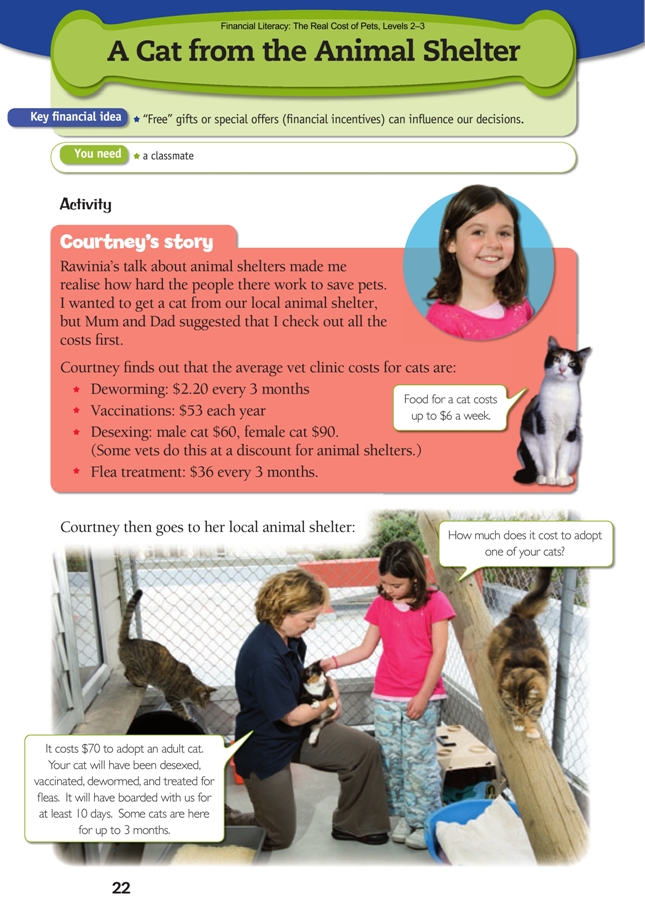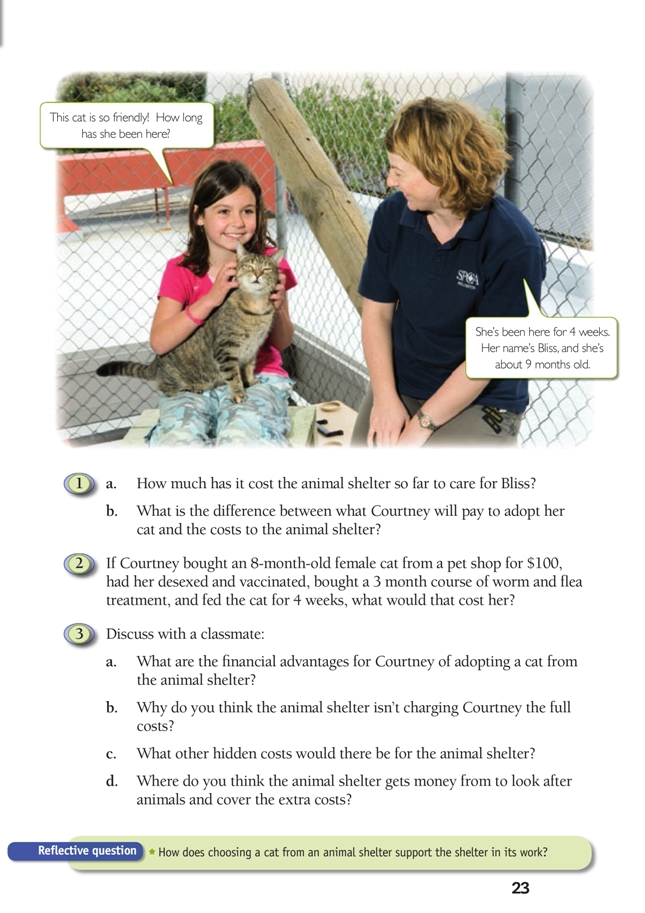This is a level 3 number and algebra activity from the Figure It Out series. It relates to Stage 6 of the Number Framework.
A PDF of the student activity is included.
Click on the image to enlarge it. Click again to close. Download PDF (2272 KB)
use mental strategies to calculate costs
Number Framework Links
Students at stage 5 could independently use a calculator to assist them but will need teacher support for understanding the numbers being used. Alternatively, you could alter the prices to whole numbers, and the students could then work relatively independently and would make more sense of the answers. Students at stage 6 should be able to use numeracy strategies to solve problems. (See the table of NDP material on page 4.)
A classmate
Financial understanding
Behind this activity is the notion that discounted prices (sales, “free” gifts, and so on) are often used as an incentive to get people to buy a particular product or service. These often influence people’s decisions as to whether to buy or not. These decisions determine how well off those people are now and may affect how well off they will be in the future. (The students could discuss at home the “buy one, get one free” type of advertising and collect examples to share in class.)
Successful financial decisions are based on collecting, organising, and analysing information, which also needs to be communicated. Courtney demonstrates this when she investigates the costs of getting a cat from the animal shelter.
Mathematics and statistics
For this activity, the students need to know how many days/weeks there are in a month/year and understand what the term “average” means. You may need also to discuss what is meant by “financial incentives”.
You could begin this activity by having the students survey or discuss where their pets came from (adopted from the SPCA or another animal shelter, bought from a pet shop, given to them, born at home, and so on). This would then lead naturally into the activity. The students could display the information on a chart or graph.
Discuss why male cats are so much cheaper to desex. (Some students may not be able to cope with this!) With questions 2 and 3, you may need to emphasise that the focus here is financial advantages, not emotional or social ones.
If you were using this activity with your whole class, students at stages 2–3 could design a label or a brochure for a flea treatment, for example, rather than work on the mathematical aspects of this activity.
Further tasks
The students could extend their work by doing one or more of the following:
• Debate whether it is actually kind or fair to give a pet to someone.
• Conduct a plus, minus, interesting (PMI) evaluation on whether to adopt or buy a pet.
• Discuss why we have to have collars on dogs but not on cats; why we have to register dogs but not cats; why dogs have to be kept in fenced areas or on leads at certain times or in certain places; why dogs get put into pounds if they are wandering or stray but cats don’t.
Social Sciences Links
Achievement objectives:
• Understand how people make significant contributions to New Zealand’s society (Social Studies, level 2)
• Understand how people make choices to meet their needs and wants (Social Studies, level 2)
• Understand how people make decisions about access to and use of resources (Social Studies, level 3)
The students could research the contribution of voluntary organisations to New Zealand’s society. Are there organisations that do the same work for profit? What do the people in the voluntary organisations get from being involved? What trade-offs (opportunity costs) might they be making?
Other Cross-curricular Links
The Arts achievement objective:
• Developing ideas: Develop and sustain ideas in drama, based on personal experience and imagination (Drama, level 2)
Your students could visit a junior class and educate them, through a drama or dance performance, on what needs to be done to care for their pets.
English achievement objectives:
• Language features: Show some understanding of how language features are used for effect within and across texts (Listening, Reading, and Viewing, level 2)
• Purposes and audiences: Show a developing understanding of how to shape texts for different purposes and audiences (Speaking, Writing, and Presenting, level 3)
The students could create an advertisement from the perspective of a pet seeking new owners (consider radio, TV advertisement, written notice, newspaper, and so on).
Science achievement objective:
• Life processes: Recognise that all living things have certain requirements so they can stay alive (Living World, level 2)
Health and Physical Education achievement objective:
• Personal growth and development: Describe their stages of growth and their development needs and demonstrate increasing responsibility for self-care (Personal Health and Physical Development, level 2)
You could focus on neglect or mistreatment of animals and extend this into a “keeping ourselves safe” type of session focusing on what we need in order to be well cared for.
Answers to Activity
1. a. $205.20 ($90 + $53 + $2.20 + $24 + $36) plus hidden costs such as power, phone, other running expenses
b. $135.20. ($205.20 – $70)
2. Approximately $305.20. ($100 + $90 + $53 + $2.20 + $36 + $24)
3. Answers will vary. For example:
a. It will cost Courtney less than buying a cat from a pet shop and then going to a vet for desexing; vaccinations and other treatment have already been done.
b. They want to find good homes for as many animals as possible, so they try to make it affordable.
c. Hidden costs would include power, phone, heating, equipment, cages, any wages,
transport cost if picking up animals, advertising, and treatment costs for sick animals.
d. Answers will vary. They might apply for grants from businesses, receive donations,
or do fund-raising.
Reflective question
Answers will vary. It means they don’t have to keep spending money on that animal for food and housing and they get some of the money back that they have spent. They’ll be pleased to have found a good home for one of their animals.

